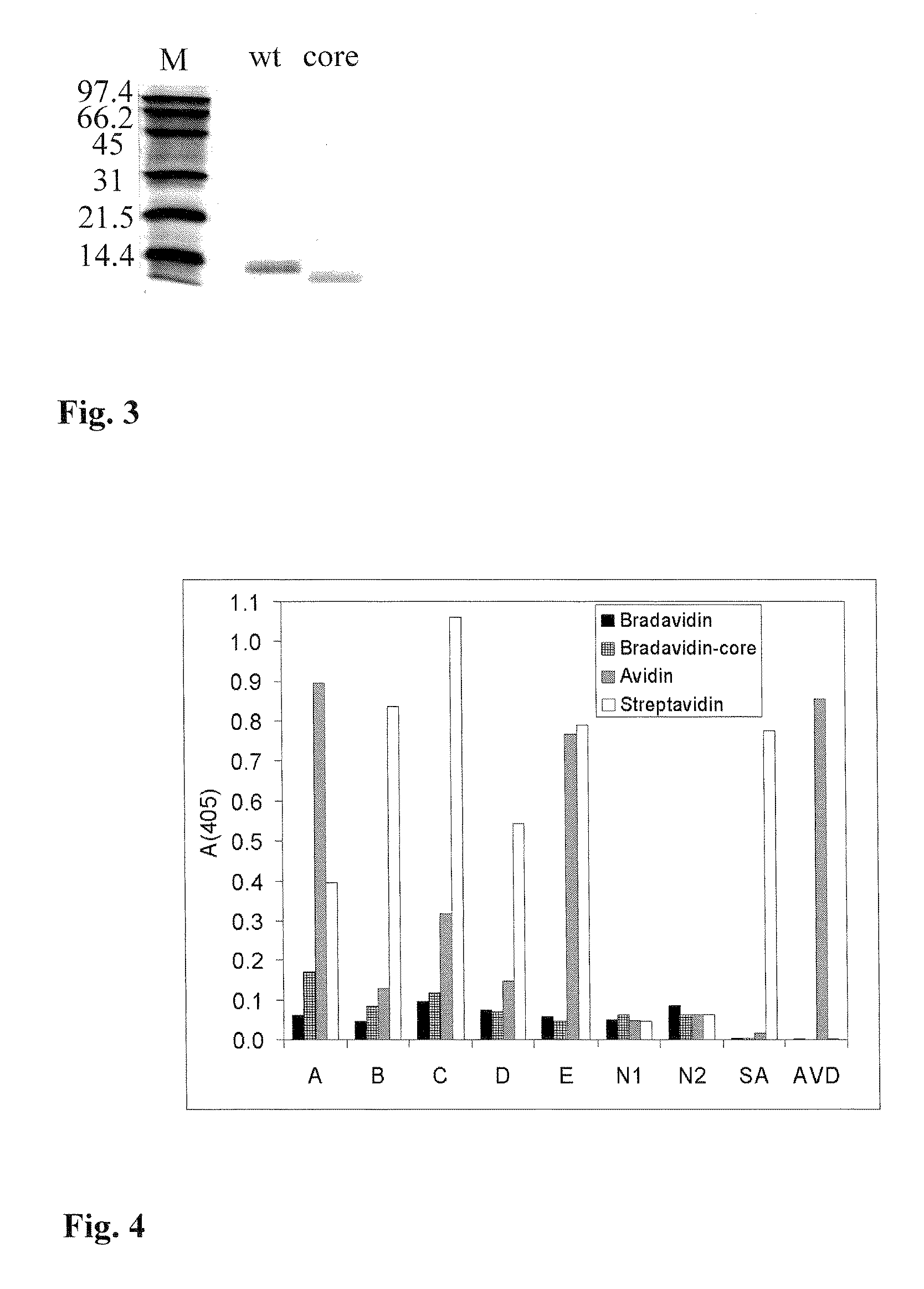Avidin-like proteins from symbiotic bacteria
a technology of symbiotic bacteria and proteins, applied in the field of new avidinlike proteins, can solve the problems of ineffective use of soil microorganisms, insects and also higher animals, and inability to protect soil microorganisms
- Summary
- Abstract
- Description
- Claims
- Application Information
AI Technical Summary
Benefits of technology
Problems solved by technology
Method used
Image
Examples
example 1
Production and Purification of Bradavidin
[0032]The gene coding for bradavidin (DBJ AP005955.1) was amplified by PCR using B. japonicum genomic DNA as a template, and extended using SES-PCR (Majumder, 1992) to include attL recombination sites at both ends (Hartley et al., 2000). Two constructs were generated: the full length wild-type (138 amino acid residues, SEQ. ID NO:1) and a C-terminally truncated core form (118 amino acid residues, SEQ ID NO:2). Both constructs contained also their innate signal peptides (25 amino acid residues), which is represented together with the wild type protein (163 amino acid residues) in SEQ ID NO:5. These constructs were then transferred to pBVboostFG vector (Laitinen O. H. et al., manuscript) using the site-specific recombination-based Gateway method (invitrogen). The resulting expression vectors were confirmed to be as designed by DNA sequencing.
[0033]E. coli BL-21 (AI) cells (Invitrogen) were used for protein expression as described previously (Hy...
example 2
Primary Structure Analysis
[0034]Pairwise sequence alignments were done using the Needle program from the EMBOSS (European Molecular Biology Open Software Suite) package and the ClustalW program was used to generate the multiple sequence alignment (Thompson et al., 1994). The theoretic biochemical properties were determined using the ProtParam program (Gill and von Hippel, 1989). The putative signal peptide cleavage site was determined by the SignalP 3.0 program (Bendtsen et al., 2004).
[0035]Pairwise sequence alignment for mature core regions of avidin and bradavidin revealed that 29.2% of the amino acids are identical and 39.2% similar, whereas with streptavidin these values are 30.2% and 41.7%, respectively. Interestingly, when avidin and streptavidin are compared equivalently the values obtained, 31.9% and 45.2%, are only slightly higher. Multiple sequence alignment of streptavidin, bradavidin and avidin (FIG. 1) revealed that most of the conserved residues are directly involved i...
example 3
Analysis of Function and Properties
[0036]Ligand binding properties were studied both by [3H]biotin assay and fluorescent biotin conjugate assay. The dissociation rate constant of [3H]biotin (Amersham) from the bradavidins and avidin was measured at various temperatures as described in detail previously (Klumb et al., 1998). According to the results, (Table I, FIG. 2) the faster dissociation rate measured from bradavidin indicates weaker affinity toward the radiobiotin than those of avidin and streptavidin. The dissociation rate of a fluorescent biotin conjugate (ArcDia BF560™-biotin) was measured as previously described (Hytönen et al., 2004a) at 50° C. However, bradavidin showed a clearly slower rate of fluorescent biotin displacement than that of avidin, thus proving to be almost as extreme biotin conjugate binder as streptavidin (Pazy et al., 2002).
[0037]The purified proteins were analysed by gel filtration using a Shimadzu HPLC instrument equipped with a Superdex 200 HR 10 / 30 co...
PUM
| Property | Measurement | Unit |
|---|---|---|
| pH | aaaaa | aaaaa |
| length | aaaaa | aaaaa |
| affinity | aaaaa | aaaaa |
Abstract
Description
Claims
Application Information
 Login to View More
Login to View More - R&D
- Intellectual Property
- Life Sciences
- Materials
- Tech Scout
- Unparalleled Data Quality
- Higher Quality Content
- 60% Fewer Hallucinations
Browse by: Latest US Patents, China's latest patents, Technical Efficacy Thesaurus, Application Domain, Technology Topic, Popular Technical Reports.
© 2025 PatSnap. All rights reserved.Legal|Privacy policy|Modern Slavery Act Transparency Statement|Sitemap|About US| Contact US: help@patsnap.com



